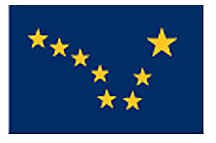
Alaska
|
Klondike Gold Rush |
Click on either map to see it in detail |
|
Origin of the name, Alaska |
The word “Alaska” is derived from the Aleut word “Alyeska” meaning Great Land. The State Capital is Juneau. Admission to Statehood took place on January 3, 1959 |
|
State Symbols |
Click on each link below to learn what the State's symbols are and how they came to be.
|
|
Alaska’s most important traditional industries are seasonal, unpredictable, and often dangerous “boom-and-bust” industries. Fur-trapping and mining were its earliest industries, followed by fishing and lumber. Traditional gold mining has been replaced by the high-tech recovery and transportation of oil and natural gas, which are nonrenewable resources; in other words, they will not last forever. All sectors of Alaska’s economy are natural resource-based. Oil transported by the Alaskan Pipeline, from Prudhoe Bay to the port of Valdez, is of greatest importance to the state’s economy but indications are that the supply might be drying up. Currently, oil revenues supply 85% of the state budget. Every Alaskan resident receives a yearly payment of about $1,000 from an oil-funded “permanent fund dividend.” Mining—Historically, the Klondike Gold Rush and later discoveries in Nome and elsewhere played a major role in Alaska’s development. However, gold is no longer mined in quantity. Alaska holds half of the United States coal reserves. Fishing—Fishing is the third most important sector of Alaska’s economy. Commercial fishing began in the 1870s, and Alaska’s marine foods industry now ranks first in the nation in both quantity and commercial value, with a wealth of salmon, halibut, herring, cod, crab, and shrimp. Each year nearly 6 billion pounds of seafood are harvested with Alaska being the number one producer of wild salmon in the world. Forestry—With the two largest national forests in the nation, Alaska’s timber industry—based mostly on hemlock and spruce— is second in importance to fishing. Its national forests are located near sea transportation, and most forest products are exported to Japan. The value of this sector has diminished due to the economic recession in Japan. Fur-trapping—Alaska’s oldest industry is practiced by both whites and Alaska Natives, who have made clothing from animal skins for centuries. Alaska was discovered by Russians searching for the fabulous fur of the sea otter, which was hunted nearly to extinction. Today, beaver, lynx, fox, and marten are among the most commonly trapped animals, while valuable fur seal skins are harvested in the Aleutian Islands. Tourism is second in economic importance with the numbers of tourists increasing each year. The state currently attracts over 1.1 million visitors annually. Agriculture—Though famed for the giant vegetables grown in the Matanuska Valley, Alaska ranks last among the 50 states in agriculture. Other important economic sectors include government and defense activity, which has provided highways, airfields and permanent military bases. |
|
Alaska Links |
Alaska Kid's Guide |
Denali Nat'l Park |
|
Home Alaska & the Yukon Far North Journal |
Source: www.netstate.com, www.geobop.com and the Alaska Dept. of Community and Economic Development,
Kim and Don Greene, Authors; publication date April 20, 2002